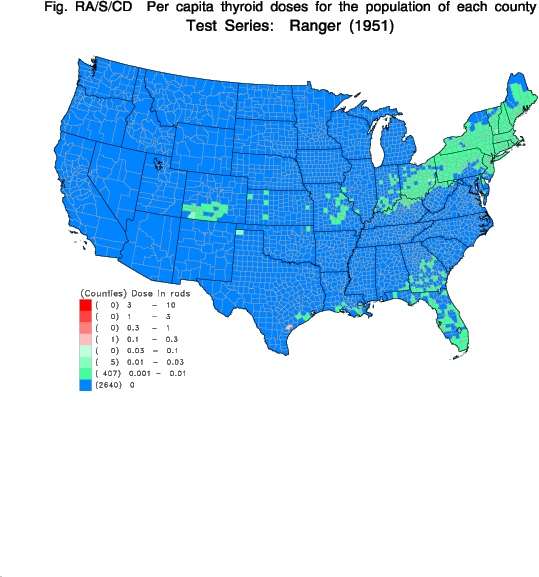

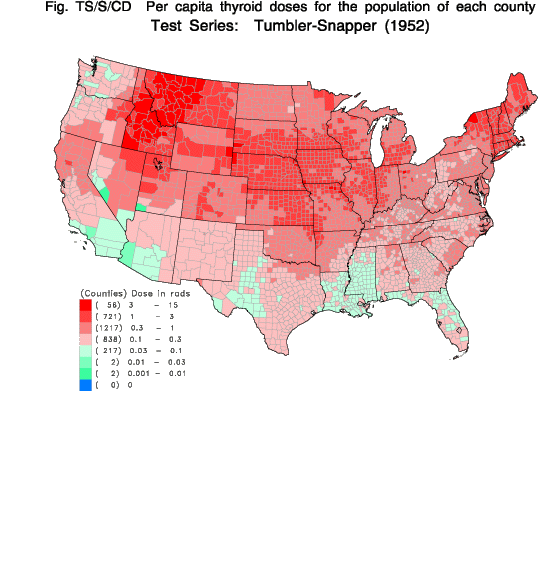
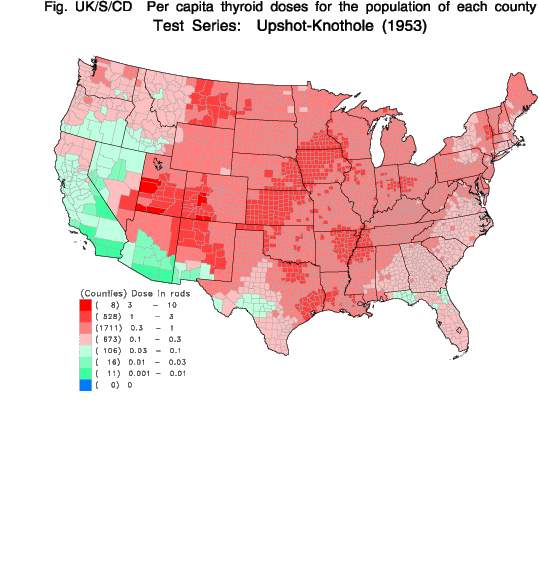
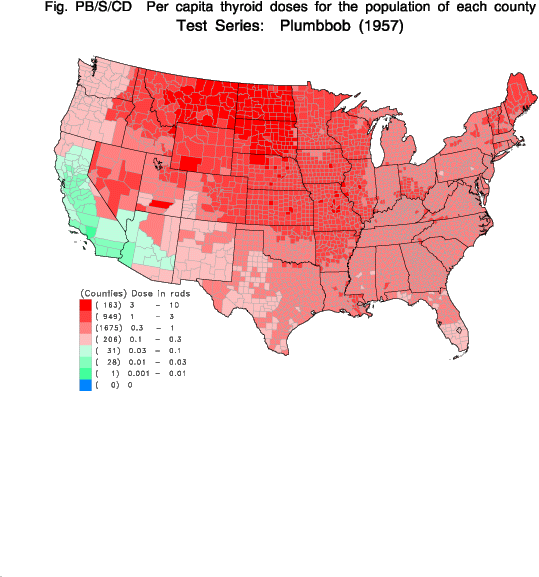

Posted on 09/04/2004 5:49:28 PM PDT by neverdem
EMMETT, Idaho, Aug. 31 - In the 1950's and early 1960's, at the height of the cold war, people in this southeastern Idaho town thought what they occasionally saw dusting their fruit orchards and cow pastures was frost - only it was not cold to the touch, several longtime residents said. Others described it as a gray-white powder that seemed to come out of nowhere.
The residents of this town of dairy and cattle farmers did not know it then, but half a century ago, northern winds blew radioactive fallout into southeastern Idaho when the federal government set off about 90 nuclear bombs at its Nevada test site near Las Vegas.
There is not any doubt that Emmett, population 5,500, and other towns in four Idaho counties were exposed to high levels of radiation from the open-air atomic bomb blasts, receiving among the highest doses of a radioactive chemical that has been linked to increased risk for thyroid cancer. The National Cancer Institute in 1997 released a detailed study and a map plotting the locations of the fallout across the country, ranking concentrations of Radioactive Iodine-131, an isotope released when a nuclear bomb is detonated, from Nevada to upstate New York. The study put the four Idaho counties - Gem County, which includes Emmett; Lemhi; Blaine; and Custer - and one in Montana at the top of that list.
But few Emmett residents heard about that study, dozens said in recent interviews. Even as sick residents of other Western states received compensation from the government, the question of how Idahoans may have been affected by the nuclear tests received little attention. But now a furor has erupted here and elsewhere in Idaho, set off by one Emmett native, who survived thyroid cancer but is dying of breast cancer that has spread to her liver and her bones.
The native, Sheri Garman, 52, who now lives in Vancouver, Wash., wrote a long letter to an Idaho state legislator - a high school classmate - after learning that the National Academy of Sciences, at the request of the federal government, is currently re-evaluating the extent of the fallout from the Nevada test site and its connection to other cancers and diseases besides thyroid cancer.
The academy's Board on Radiation Effects Research has held three hearings on the matter over the last year, two in Utah, including one on July 29, and one in Arizona.
"I think Idahoans were severely misled on the seriousness of the situation," Ms. Garman wrote on July 14 to Kathy Skippen, a state representative from Gem County. "It's not just thyroid cancer. It's not insignificant. It's deadly, expensive and it is known."
Like many Emmett residents, Ms. Garman grew up on a dairy farm, drinking fresh milk. Children of her generation living in places like Emmett, where the 1997 cancer institute study showed residents had received large doses of Radioactive Iodine-131, are at greater risk for developing thyroid cancer because the cows ingested contaminated grass.
The study, of 3,071 counties, concluded the fallout caused or would eventually cause tens of thousands of cases of thyroid cancer. Radiation from fallout is measured in rads; one rad is equivalent to the amount of radiation absorbed by the thyroid of a person who has 10 X-rays in the neck area. Residents of the four Idaho counties, the study said, received average thyroid doses of 12 to 16 rads, but the dose to some children may have been as high as 100 rads.
Idaho officials, including Gov. Dirk Kempthorne, then a United States senator, responded to the study by calling the situation an "outrage" and demanding further investigation. At the time Mr. Kempthorne also asked that Idaho be included in a government compensation program that now provides $50,000 each to residents of 21 counties in Utah, Nevada and Arizona whose illnesses have been diagnosed with any of 19 cancers. But Idaho residents were not included in the compensation program, which has thus far paid $780 million to other "down winders" exposed to radiation during the bomb tests as well as employees at the weapons testing sites and uranium mine and mill workers.
"What we need now," Ms. Garman said in a telephone interview, "is to get public hearings in Idaho. We need our politicians to be our watchdogs. We're too sick, and we're not all going to be there when this happens."
Critics say that Governor Kempthorne and other officials, after initially expressing concern, have ignored the public health threat to Idaho residents. Nuclear watchdog groups have also questioned whether the officials' reluctance to press the issue was intended to protect Idaho's nuclear power industry, a major employer in the state, or because they supported the idea of resuming nuclear testing, as was proposed in a Pentagon report in 2002. State officials denied such motivations.
The controversy prompted Mr. Kempthorne and Senator Larry E. Craig, both Republicans, to take the unusual step of defending themselves two weeks ago on the editorial pages of the state's largest newspaper, The Idaho Statesman.
The governor, in an article published on Aug. 18, said, "I urge anyone with a story to tell to come forward."
But he also cited a 1998 study by the Cancer Data Registry of Idaho that found an increasing rate of thyroid cancer in Blaine and Custer Counties, but was unable to attribute the rising rates to a specific cause.
Asked why the governor had waited until now to urge Idaho residents to come forward if they suspected fallout had made them sick, a spokesman for Mr. Kempthorne, Mike Journee, said that the governor was waiting for concrete proof. He said the governor would support compensation for Idahoans if there were evidence "comparable to the evidence that was used to compensate folks in Utah."
Yet when the compensation program was amended in 2000 at the urging of Senator Orrin G. Hatch of Utah to include more counties in his state and in Arizona, Utah officials had the same scientific information- the 1997 Cancer Institute study - available to them as Idaho officials did. Utah officials cited testimony of residents from Utah and Arizona that was made available to Mr. Hatch's office as a rationale for including five more counties in those two states.
Senator Hatch, a Republican, wrote the original 1990 law that mandated compensation, known as the Radiation Exposure Compensation Act; the payments are administered by the Justice Department.
Mr. Journee said that Utah residents had been more vocal about their illnesses than Idahoans had.
"They were engaged," he said. "The reason folks down in Utah got compensation is that they told their stories. That's what the governor wants the people of Idaho to do."
[On Friday, Mr. Kempthorne wrote in a letter to the National Academy of Sciences board studying the issue, "I call upon the board to compare exposure information for Idaho with the areas currently included" in the compensation program. "Fairness," he wrote, "must recognize the human faces behind cold, and often inconclusive studies and statistics."]
Here in Emmett, residents have spent the last several days making lists of relatives and neighbors - living and dead - with cancer. They have rushed to a local bakery, aptly named the Rumor Mill, where the owner, Tona Henderson, has produced a form letter of her own that residents can fill out and send to the National Academy of Sciences.
A committee of the academy is taking public comment for a study on nuclear fallout and public health to be submitted to the Department of Health and Human Services, said Bill Kearney, a spokesman for the academy. While many scientists and medical experts have said there is a connection between exposure to Iodine-131 and greater risk of thyroid disease and thyroid cancer, a link between the fallout and other diseases has not been established.
Still, in Emmett, dozens of residents have gathered in coffee shops and farmhouses to talk about cancer. Many furiously said they suspected their radiation exposure was connected to their cancers.
"This whole thing is wrong," said Richard Rynearson, 62, who is dying of colon and liver cancer, and who ran a heating and air-conditioning business until he became too sick to work. "Somebody needs to own up to the fact that they messed up."
Mr. Rynearson, who recalled seeing that strange gray dust on the dairy farm where he grew up, said he first learned of the nuclear fallout last week.
"I always thought maybe there was something wrong in this valley," he said. "But I would have liked to have known 10 years ago if we had this problem. Maybe I could have gotten checked out."
Could you explain that?
Your neck of the woods ping...
I'm sorry to read about the loss of your mother. Thank's for the info.
Thanks for the map. Where did you find it?
I'm a "Downwinder," too. We moved to Payson (Utah Valley) in 1949, and lived there for the entire decade of the fifties, until 1964. The prevailing winds in the valley are from the southwest.
I remember the iodine tablets they gave us at school every month, and I know that now, my two sisters and I all have seriously impaired thyroid function, in spite of the iodine.
http://www.llnl.gov/tid/lof/documents/pdf/197594.pdf
http://www.nv.doe.gov/news&pubs/publications/historyreports/Radiological.htm






Thanks for the links and maps.
A committee of the academy is taking public comment for a study on nuclear fallout and public health to be submitted to the Department of Health and Human Services, said Bill Kearney, a spokesman for the academy. While many scientists and medical experts have said there is a connection between exposure to Iodine-131 and greater risk of thyroid disease and thyroid cancer, a link between the fallout and other diseases has not been established.
Still, in Emmett, dozens of residents have gathered in coffee shops and farmhouses to talk about cancer. Many furiously said they suspected their radiation exposure was connected to their cancers.
"This whole thing is wrong," said Richard Rynearson, 62, who is dying of colon and liver cancer, and who ran a heating and air-conditioning business until he became too sick to work. "Somebody needs to own up to the fact that they messed up."
Junk science alert.
Let's review the facts. The residents of this area got about 15 rads in the space of several years (some few may have been exposed to as much as 100 rads). A Rad is a unit of absorption, a Rem is a unit of exposure (a more accurate measure of how threatening the absorbed radiation is). The most dangerous radiation exposures tend to have 1 Rad = 1 Rem. We'll use that as our worst case scenario.
Short term exposures to radiation are the most dangerous, while long term exposure to low levels has no observably deleterious effect. Every American absorbs between .06 and .6 Rems of radiation per year just from his natural surroundings. Studies have shown that doses below 100 rems have no observable effect on cancer rates, and that doses as high as 300 rems are necessary to get significant (50%) cancer rates. So, what does this story tell us? Most exposures were far below the threshold for any effect at all, while a handful may have been exposed to the very lowest amount that might have an effect.
Second, epidemiology is a very strict science, and what we have is very anecdotal information in the story. Radioactive iodine causes mostly thyroid cancer, yet the residents blame many different varieties of cancer on the fallout. This is a perfect example of the post hoc, ergo propter hoc logical fallacy ("after this, therefore because of this"). Fact: nearly three in four Americans will get cancer of some kind and nearly one in four will die of it. Cancer is a disease of the elderly, and it is a natural function of the body's cellular systems breaking down and malfunctioning due to aging. Epidemiologists track disease and cancer threats based on quantifiable and measurable increases in effects. For example, when coupled with specific exposure to a known substance, higher rates of rare forms of cancer, cancer localized in patients (such as in the liver or thyroid), or cancer occuring at young ages all are valid indicators of a possible effect. But clusters of cancers occur in then population at random as well (that's what "random" means), so rigorous statistical methodology is necessary. Besides, someone has to be the person that gets the one-in-a-million cancer...
Continued below ->
This is Love Canal or DDT redux. But expect our tax dollars to get drained to pay people whose cancers have nothing to do with the fallout, simply because big government wants to show it cares (and cover its own a** from the scientific illiterates out there who easily get stirred up about these enviro-scares).
PING!
Looks like the Canadians might want to see the map in #13 extended.
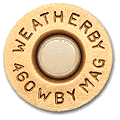
Stay safe.....
Seems to me they had an accident at the SL-1 reactor there in the '50's also. You might check that out.
WHEW! I can keep smoking!
A large number of my friends born in 55-6-7 in Western North Dakota have died of cancer. Hmmmmmm. Maybe coincidence, maybe not...(plumbob tests)
This is no different than the power line cancer scare of a few years ago.
I have the report form that accident. The reactor operators died in that one.
I Understand there was at least one tech in the containment who took a while to remove. Not sure about releases, though.
Disclaimer: Opinions posted on Free Republic are those of the individual posters and do not necessarily represent the opinion of Free Republic or its management. All materials posted herein are protected by copyright law and the exemption for fair use of copyrighted works.